外研版(2019)选择性必修 第二册Unit 6 Survival Starting out&Understanding ideas课件(共33张,内嵌视频)
文档属性
| 名称 | 外研版(2019)选择性必修 第二册Unit 6 Survival Starting out&Understanding ideas课件(共33张,内嵌视频) | 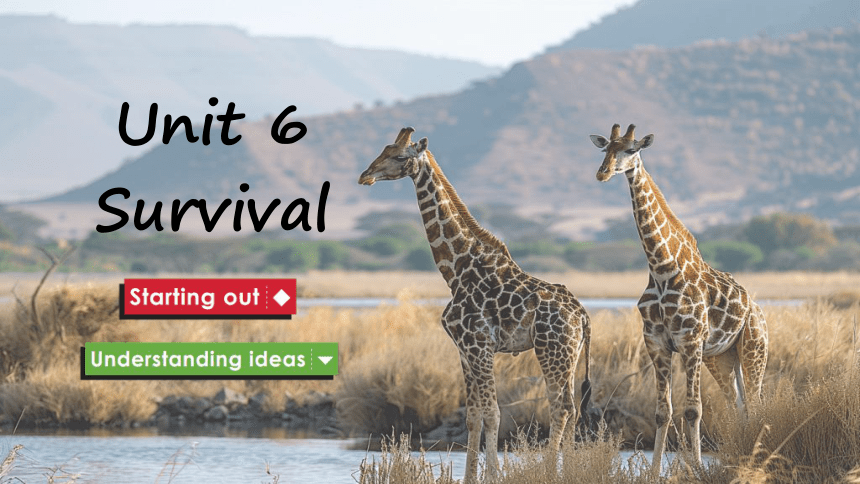 | |
| 格式 | pptx | ||
| 文件大小 | 92.9MB | ||
| 资源类型 | 教案 | ||
| 版本资源 | 外研版(2019) | ||
| 科目 | 英语 | ||
| 更新时间 | 2024-11-01 09:18:36 | ||
图片预览

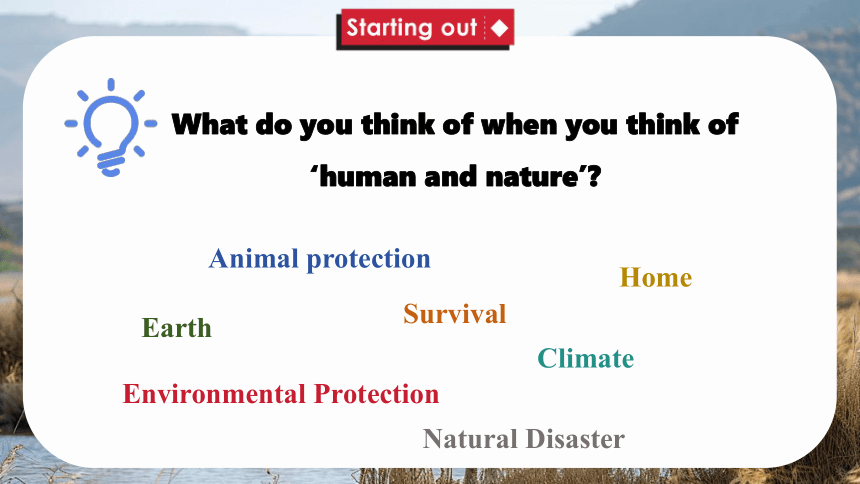
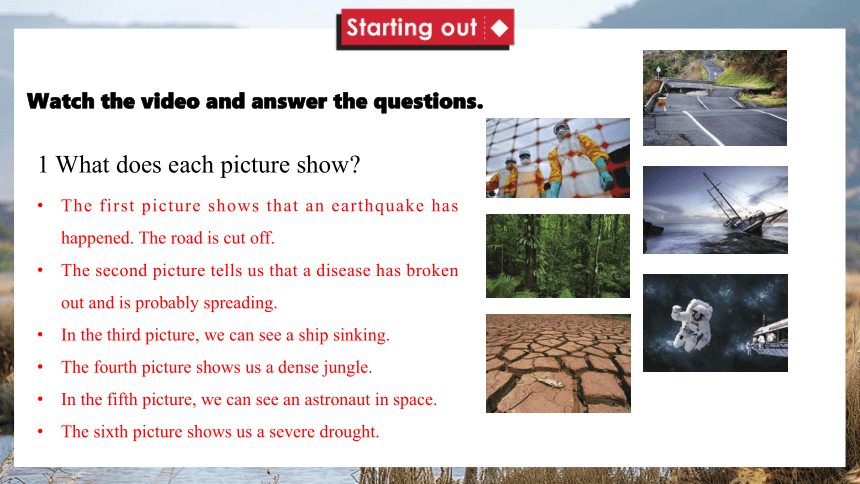
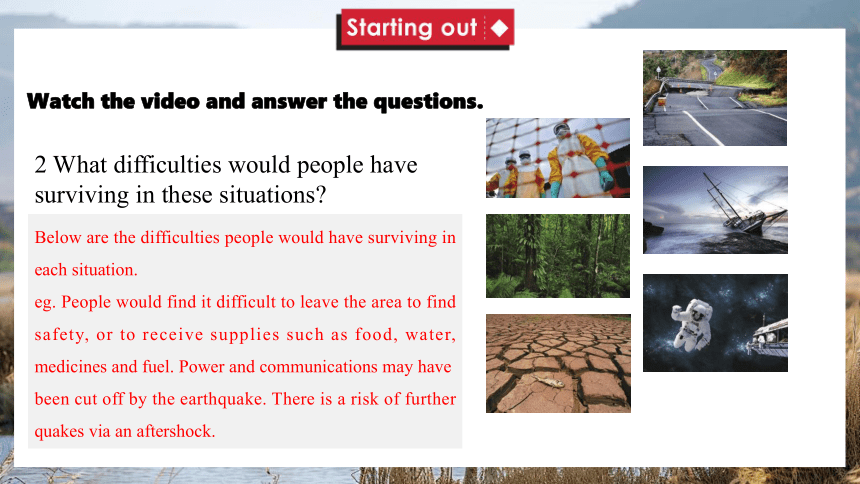
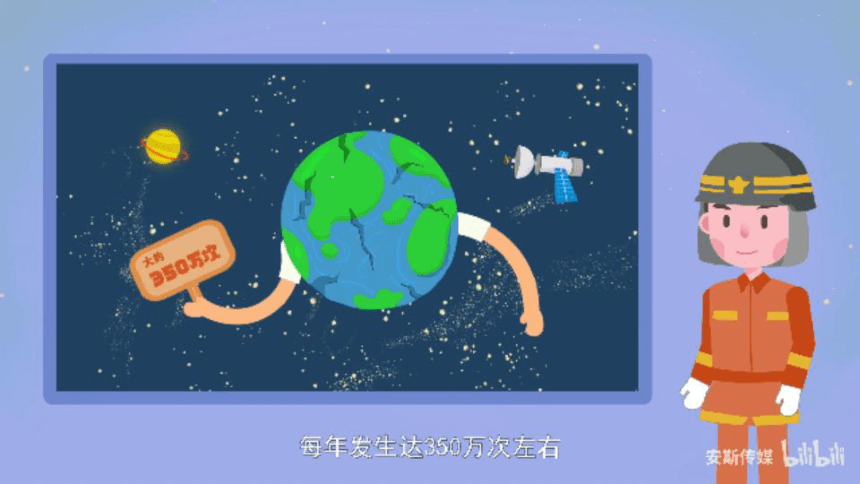
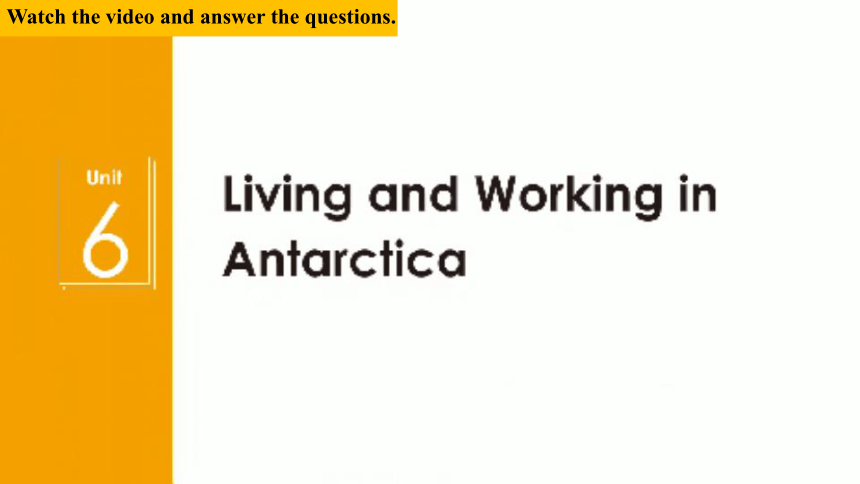
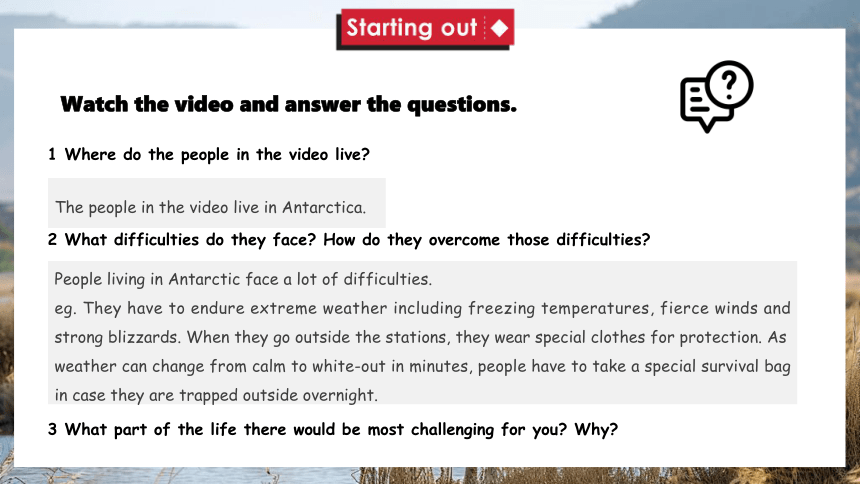
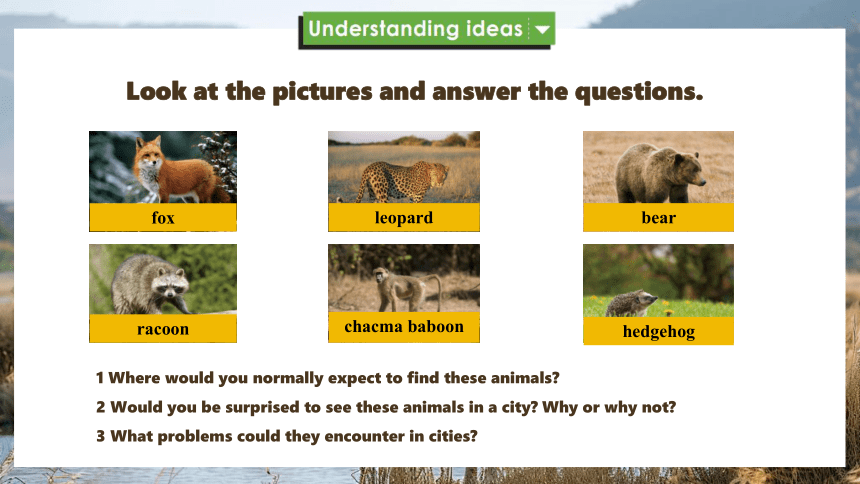
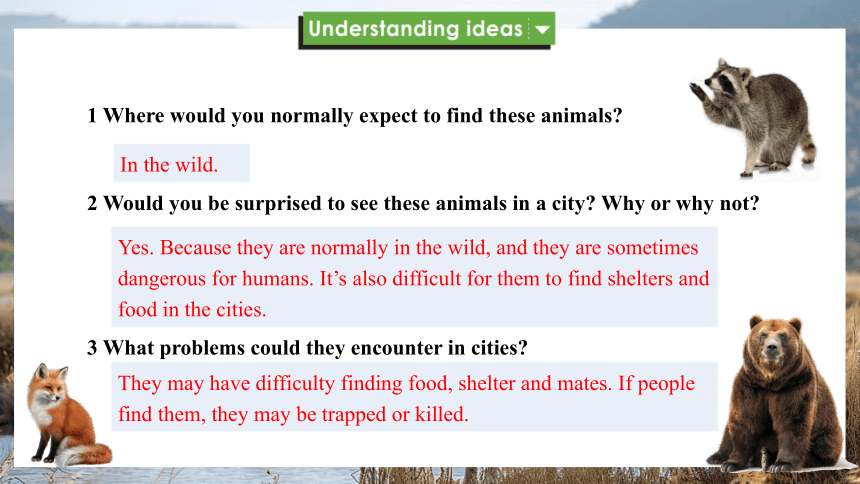
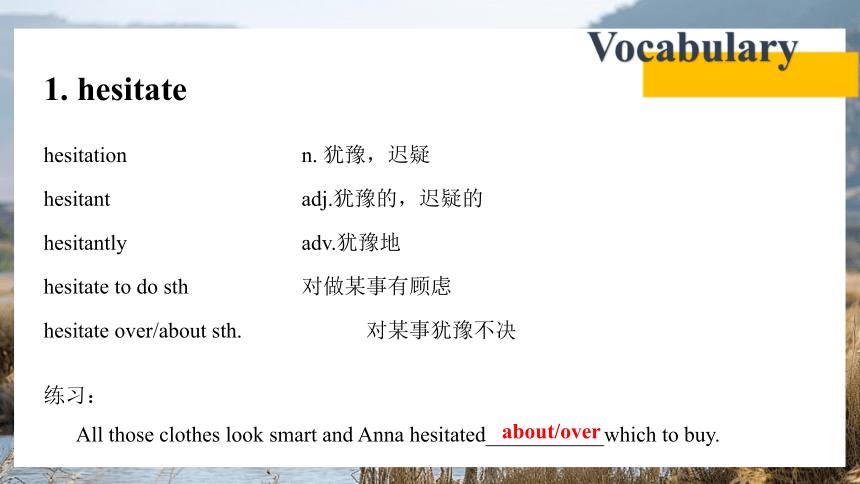
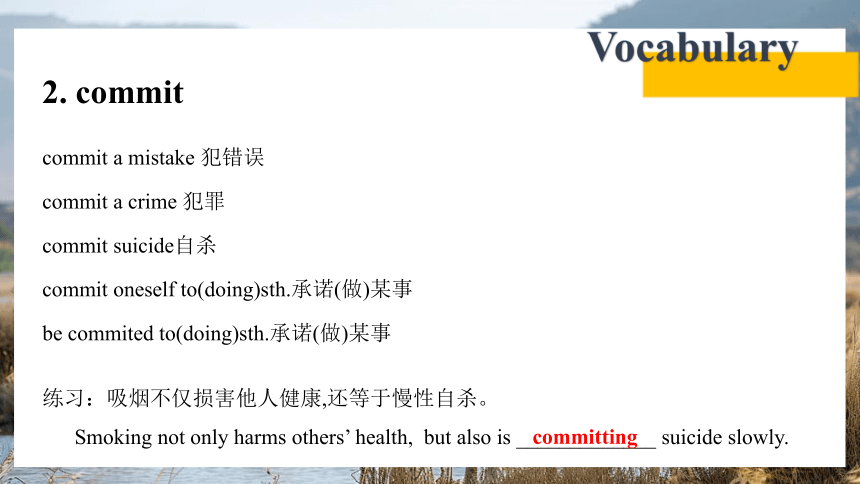

文档简介
(共33张PPT)
Unit 6
Survival
What do you think of when you think of ‘human and nature’
Animal protection
Environmental Protection
Climate
Natural Disaster
Earth
Survival
Home
Watch the video and answer the questions.
1 What does each picture show
The first picture shows that an earthquake has happened. The road is cut off.
The second picture tells us that a disease has broken out and is probably spreading.
In the third picture, we can see a ship sinking.
The fourth picture shows us a dense jungle.
In the fifth picture, we can see an astronaut in space.
The sixth picture shows us a severe drought.
Watch the video and answer the questions.
2 What difficulties would people have surviving in these situations
Below are the difficulties people would have surviving in each situation.
eg. People would find it difficult to leave the area to find safety, or to receive supplies such as food, water, medicines and fuel. Power and communications may have been cut off by the earthquake. There is a risk of further quakes via an aftershock.
Watch the video and answer the questions.
1 Where do the people in the video live
2 What difficulties do they face How do they overcome those difficulties
3 What part of the life there would be most challenging for you Why
Watch the video and answer the questions.
The people in the video live in Antarctica.
People living in Antarctic face a lot of difficulties.
eg. They have to endure extreme weather including freezing temperatures, fierce winds and strong blizzards. When they go outside the stations, they wear special clothes for protection. As weather can change from calm to white-out in minutes, people have to take a special survival bag in case they are trapped outside overnight.
Look at the pictures and answer the questions.
fox
leopard
bear
racoon
chacma baboon
hedgehog
1 Where would you normally expect to find these animals
2 Would you be surprised to see these animals in a city Why or why not
3 What problems could they encounter in cities
1 Where would you normally expect to find these animals
2 Would you be surprised to see these animals in a city Why or why not
3 What problems could they encounter in cities
In the wild.
Yes. Because they are normally in the wild, and they are sometimes dangerous for humans. It’s also difficult for them to find shelters and food in the cities.
They may have difficulty finding food, shelter and mates. If people find them, they may be trapped or killed.
Vocabulary
1. hesitate
hesitation n. 犹豫,迟疑
hesitant adj.犹豫的,迟疑的
hesitantly adv.犹豫地
hesitate to do sth 对做某事有顾虑
hesitate over/about sth. 对某事犹豫不决
练习:
All those clothes look smart and Anna hesitated___________which to buy.
about/over
Vocabulary
2. commit
commit a mistake 犯错误
commit a crime 犯罪
commit suicide自杀
commit oneself to(doing)sth.承诺(做)某事
be commited to(doing)sth.承诺(做)某事
练习:吸烟不仅损害他人健康,还等于慢性自杀。
Smoking not only harms others’ health, but also is _____________ suicide slowly.
committing
Vocabulary
3. crash
crash(...)into... (使…)撞上……
a car crash 汽车撞车事故
a plane crash 飞机失事
练习:许多投资者在最近的股票市场暴跌中损失惨重。
Many investors suffered huge losses in the recent stock market ________.
crash
Vocabulary
4. impact
have an impact on sth./sb.对……有影响
impact on/upon sth.对……造成影响
练习:帮助残疾人的建议产生了积极的反响,对年轻一代的影响将是持久的。
There has been positive reaction to the suggestion to help the disabled, the ________of
which will be lasting for younger ones.
impact
Look at the title of the passage and the picture.
Think about what the title means.
Look at the title of the passage and the picture.
Think about what the title means.
In this picture, we can see a squirrel, birds, butterflies and some racoons. These animals are living in a city which is ruled by human beings.
The title means the wild animals within the cities.
The benefits that a city can offer to these newcomers.
More and more wild animals are entering our cities.
Wild animals’ ability to adapt themselves to the city life.
We should get a better understanding of these wildanimals.
The reason behind this mass urban migration.
Dangers for some animals that can't adapt.
Match the paragraphs with the main ideas.
para. 1
para. 2
para. 3
para. 4
para. 5
para. 6
Read the passage quickly and answer the following questions.
questions.
How many kinds of wild animals are mentioned in the passage
A. 2.
B. 3.
C. 4.
D. 5.
Read the passage quickly and answer the following questions.
questions.
What did most people think pushed these animals into the city
A. We human beings.
B. The destroy of nature.
C. The change of their living habits.
D.Urban development and climate change.
Read the passage quickly and answer the following questions.
questions.
What should we do to achieve a balance between urban development and the protection of wildanimals
A. Drive these animals out of our cities.
B. Understand better and appreciate them.
C.Offer what we can to these wild animals.
D. Try our best to protect these wild animals.
Read the passage quickly and answer the following questions.
questions.
What does the word “they" in the first sentence of the third paragraph refer to
A. Our cities.
B. New habitats.
C.These animals.
D.Appealing spaces..
Choose the topic sentences for Paragraphs 2-5 and write them on the lines to complete the passage.
a One thing crucial to the increasing number of “urban animals” is their ability to adapt.
b People often wonder about the reasons behind this mass urban migration.
c For those animals that don't adapt, the city can be a dangerous or even deadly place.
d Yet, for its newest and wildest inhabitants, a city can offer many benefits.
Para. 2—b Para. 3—d Para. 4—a Para. 5—c
Organise information from the passage and complete the diagram.
1 out of their natural habitats
2 Wherever they go, animals find towns and cities in their way. With nowhere else to make their homes, they have no choice but to move in with us.
3 Out of reach from many of their natural predators, these newcomers often flourish in their new city lives.
4 Hungry animals are finding plenty to eat in our gardens and in the leftovers we throw away.
5 intelligent than their wild cousins
6 Some animals have even changed their living habits to fit in with their new homes.
7 Some birds crash into windows because they are unable to distinguish between blue sky and glass.
8 Some birds have yet to change their migratory routes that take them through cities with high-rise buildings.
9 look towards harmoniously sharing our urban habitats
Now think about what people can do to achieve a balance between
the need for urban development and the protection of wild animals.
1 Humans build cities not only to make themselves live, also to let the wild animals survive.
2 When building cities, humans should not occupy the living space of wild animals.
3 It is a sign of modern civilization to let wild animals find habitats in cities just like human beings, which can contribute to a good biodiversity and a complete ecology.
Think & Share
1 How would you describe the relationship between people and urban animals in the passage
2 What figure of speech is used in the first paragraph Why does the author choose to start the passage this way
Animals have no choice but to live with us. We humans should learn to understand them, appreciate them and live with harmoniously.
In the first paragraph, the author uses personification to describe what urban animals are doing, with the aim of attracting readers’ attention.
3 Some environmentalists argue that we should restrict urban development to leave enough natural habitats for wild animals.
Do you agree with this Give your reasons.
Yes, I agree with this opinion. With the acceleration of human urbanization, more and more animals' habitats have been destroyed or invaded. This has deprived the animals of their homes and food. They have nowhere to go and face threats to their survival. Therefore, human beings should slow down the speed of urbanization.
Think & Share
Spotting the car with its window left open, the greedy thief didn't
hesitate.
with 复合结构
with 复合结构,即"with+宾语+宾补"结构,在句中通常作状语,表示伴随、方式、原因或条件等,也可作定语。宾语可由名词或代词充当。
She saw a river with red flowers and geen gass on both sides.
她看到一条两岸长着红花绿草的河流。
with 复合结构
常见的 with 复合结构
with+宾语+分词:
现在分词(表示主动或动作正在进行);过去分词(表示被动或动作已完成)
with+宾语+动词不定式(通常用 to do 形式,表示动作尚未进行)
with+宾语+介词短语/形容词/副词(表示宾语所处的状态)
with 复合结构
常见的 with 复合结构
The girl felt very safe with her mother standing behind her.
她的妈妈站在她的身后,这个女孩儿感到很安全。 (her mother与 stand 之间是逻辑上的主谓关系)
With all the things she needed bought,she went home.
买了她需要的所有西后,她回家了。(things与 buy 之间是逻辑上的动宾关系)
With so many books to read, I have no time to chat with you.
有这么多的书要读,我没时间跟你闲聊。
(books与read 之间是逻辑上的动宾关系,但不定式用主动形式表示被动意义)
Exercise
1.He had so much confidence in himself that he made all the ______ decisions by himself.
A.delicate B.secondary C.urban D.crucial
2.As a matter of fact, he was not ________ because he was inexperienced and it was the first time that he ________ this kind of mistake.
A.blamed; commits B.blamed; committed
C.to blame; has committed D.to blame; had committed
3.Emily Dickinson is generally _________ as one of the finest women poets in history.
A.restricted B.acknowledged C.designed D.employed
Exercise
4.Although values may be ____, it’s helpful to share them with your partner for additional support.
A.terminal B.personal
C.crucial D.practical
5.I would _______it if you could give us some precious advice on how to improve our English.
A.relate to B.appreciate C.lead to D.identify
6.I don’t believe what you said, but if you can prove it, you may be able to ________ me.
A.convince B.consult C.tolerate D.restrict
Exercise
7.Lying on the bed in front of me was a newly born child, without the natural _____ of hearing.
A.evacuation B.container C.emergency D.equipment
8.John was ________ from the prison after serving a sentence of 3 years.
A.restricted B.released C.sustained D.seized
9.I think she would _____ it if we could all help out a bit more.
A.thank B.appreciate C.employ D.use
Review the language points and complete the exercises.
Homework
See you next class!
Unit 6
Survival
What do you think of when you think of ‘human and nature’
Animal protection
Environmental Protection
Climate
Natural Disaster
Earth
Survival
Home
Watch the video and answer the questions.
1 What does each picture show
The first picture shows that an earthquake has happened. The road is cut off.
The second picture tells us that a disease has broken out and is probably spreading.
In the third picture, we can see a ship sinking.
The fourth picture shows us a dense jungle.
In the fifth picture, we can see an astronaut in space.
The sixth picture shows us a severe drought.
Watch the video and answer the questions.
2 What difficulties would people have surviving in these situations
Below are the difficulties people would have surviving in each situation.
eg. People would find it difficult to leave the area to find safety, or to receive supplies such as food, water, medicines and fuel. Power and communications may have been cut off by the earthquake. There is a risk of further quakes via an aftershock.
Watch the video and answer the questions.
1 Where do the people in the video live
2 What difficulties do they face How do they overcome those difficulties
3 What part of the life there would be most challenging for you Why
Watch the video and answer the questions.
The people in the video live in Antarctica.
People living in Antarctic face a lot of difficulties.
eg. They have to endure extreme weather including freezing temperatures, fierce winds and strong blizzards. When they go outside the stations, they wear special clothes for protection. As weather can change from calm to white-out in minutes, people have to take a special survival bag in case they are trapped outside overnight.
Look at the pictures and answer the questions.
fox
leopard
bear
racoon
chacma baboon
hedgehog
1 Where would you normally expect to find these animals
2 Would you be surprised to see these animals in a city Why or why not
3 What problems could they encounter in cities
1 Where would you normally expect to find these animals
2 Would you be surprised to see these animals in a city Why or why not
3 What problems could they encounter in cities
In the wild.
Yes. Because they are normally in the wild, and they are sometimes dangerous for humans. It’s also difficult for them to find shelters and food in the cities.
They may have difficulty finding food, shelter and mates. If people find them, they may be trapped or killed.
Vocabulary
1. hesitate
hesitation n. 犹豫,迟疑
hesitant adj.犹豫的,迟疑的
hesitantly adv.犹豫地
hesitate to do sth 对做某事有顾虑
hesitate over/about sth. 对某事犹豫不决
练习:
All those clothes look smart and Anna hesitated___________which to buy.
about/over
Vocabulary
2. commit
commit a mistake 犯错误
commit a crime 犯罪
commit suicide自杀
commit oneself to(doing)sth.承诺(做)某事
be commited to(doing)sth.承诺(做)某事
练习:吸烟不仅损害他人健康,还等于慢性自杀。
Smoking not only harms others’ health, but also is _____________ suicide slowly.
committing
Vocabulary
3. crash
crash(...)into... (使…)撞上……
a car crash 汽车撞车事故
a plane crash 飞机失事
练习:许多投资者在最近的股票市场暴跌中损失惨重。
Many investors suffered huge losses in the recent stock market ________.
crash
Vocabulary
4. impact
have an impact on sth./sb.对……有影响
impact on/upon sth.对……造成影响
练习:帮助残疾人的建议产生了积极的反响,对年轻一代的影响将是持久的。
There has been positive reaction to the suggestion to help the disabled, the ________of
which will be lasting for younger ones.
impact
Look at the title of the passage and the picture.
Think about what the title means.
Look at the title of the passage and the picture.
Think about what the title means.
In this picture, we can see a squirrel, birds, butterflies and some racoons. These animals are living in a city which is ruled by human beings.
The title means the wild animals within the cities.
The benefits that a city can offer to these newcomers.
More and more wild animals are entering our cities.
Wild animals’ ability to adapt themselves to the city life.
We should get a better understanding of these wildanimals.
The reason behind this mass urban migration.
Dangers for some animals that can't adapt.
Match the paragraphs with the main ideas.
para. 1
para. 2
para. 3
para. 4
para. 5
para. 6
Read the passage quickly and answer the following questions.
questions.
How many kinds of wild animals are mentioned in the passage
A. 2.
B. 3.
C. 4.
D. 5.
Read the passage quickly and answer the following questions.
questions.
What did most people think pushed these animals into the city
A. We human beings.
B. The destroy of nature.
C. The change of their living habits.
D.Urban development and climate change.
Read the passage quickly and answer the following questions.
questions.
What should we do to achieve a balance between urban development and the protection of wildanimals
A. Drive these animals out of our cities.
B. Understand better and appreciate them.
C.Offer what we can to these wild animals.
D. Try our best to protect these wild animals.
Read the passage quickly and answer the following questions.
questions.
What does the word “they" in the first sentence of the third paragraph refer to
A. Our cities.
B. New habitats.
C.These animals.
D.Appealing spaces..
Choose the topic sentences for Paragraphs 2-5 and write them on the lines to complete the passage.
a One thing crucial to the increasing number of “urban animals” is their ability to adapt.
b People often wonder about the reasons behind this mass urban migration.
c For those animals that don't adapt, the city can be a dangerous or even deadly place.
d Yet, for its newest and wildest inhabitants, a city can offer many benefits.
Para. 2—b Para. 3—d Para. 4—a Para. 5—c
Organise information from the passage and complete the diagram.
1 out of their natural habitats
2 Wherever they go, animals find towns and cities in their way. With nowhere else to make their homes, they have no choice but to move in with us.
3 Out of reach from many of their natural predators, these newcomers often flourish in their new city lives.
4 Hungry animals are finding plenty to eat in our gardens and in the leftovers we throw away.
5 intelligent than their wild cousins
6 Some animals have even changed their living habits to fit in with their new homes.
7 Some birds crash into windows because they are unable to distinguish between blue sky and glass.
8 Some birds have yet to change their migratory routes that take them through cities with high-rise buildings.
9 look towards harmoniously sharing our urban habitats
Now think about what people can do to achieve a balance between
the need for urban development and the protection of wild animals.
1 Humans build cities not only to make themselves live, also to let the wild animals survive.
2 When building cities, humans should not occupy the living space of wild animals.
3 It is a sign of modern civilization to let wild animals find habitats in cities just like human beings, which can contribute to a good biodiversity and a complete ecology.
Think & Share
1 How would you describe the relationship between people and urban animals in the passage
2 What figure of speech is used in the first paragraph Why does the author choose to start the passage this way
Animals have no choice but to live with us. We humans should learn to understand them, appreciate them and live with harmoniously.
In the first paragraph, the author uses personification to describe what urban animals are doing, with the aim of attracting readers’ attention.
3 Some environmentalists argue that we should restrict urban development to leave enough natural habitats for wild animals.
Do you agree with this Give your reasons.
Yes, I agree with this opinion. With the acceleration of human urbanization, more and more animals' habitats have been destroyed or invaded. This has deprived the animals of their homes and food. They have nowhere to go and face threats to their survival. Therefore, human beings should slow down the speed of urbanization.
Think & Share
Spotting the car with its window left open, the greedy thief didn't
hesitate.
with 复合结构
with 复合结构,即"with+宾语+宾补"结构,在句中通常作状语,表示伴随、方式、原因或条件等,也可作定语。宾语可由名词或代词充当。
She saw a river with red flowers and geen gass on both sides.
她看到一条两岸长着红花绿草的河流。
with 复合结构
常见的 with 复合结构
with+宾语+分词:
现在分词(表示主动或动作正在进行);过去分词(表示被动或动作已完成)
with+宾语+动词不定式(通常用 to do 形式,表示动作尚未进行)
with+宾语+介词短语/形容词/副词(表示宾语所处的状态)
with 复合结构
常见的 with 复合结构
The girl felt very safe with her mother standing behind her.
她的妈妈站在她的身后,这个女孩儿感到很安全。 (her mother与 stand 之间是逻辑上的主谓关系)
With all the things she needed bought,she went home.
买了她需要的所有西后,她回家了。(things与 buy 之间是逻辑上的动宾关系)
With so many books to read, I have no time to chat with you.
有这么多的书要读,我没时间跟你闲聊。
(books与read 之间是逻辑上的动宾关系,但不定式用主动形式表示被动意义)
Exercise
1.He had so much confidence in himself that he made all the ______ decisions by himself.
A.delicate B.secondary C.urban D.crucial
2.As a matter of fact, he was not ________ because he was inexperienced and it was the first time that he ________ this kind of mistake.
A.blamed; commits B.blamed; committed
C.to blame; has committed D.to blame; had committed
3.Emily Dickinson is generally _________ as one of the finest women poets in history.
A.restricted B.acknowledged C.designed D.employed
Exercise
4.Although values may be ____, it’s helpful to share them with your partner for additional support.
A.terminal B.personal
C.crucial D.practical
5.I would _______it if you could give us some precious advice on how to improve our English.
A.relate to B.appreciate C.lead to D.identify
6.I don’t believe what you said, but if you can prove it, you may be able to ________ me.
A.convince B.consult C.tolerate D.restrict
Exercise
7.Lying on the bed in front of me was a newly born child, without the natural _____ of hearing.
A.evacuation B.container C.emergency D.equipment
8.John was ________ from the prison after serving a sentence of 3 years.
A.restricted B.released C.sustained D.seized
9.I think she would _____ it if we could all help out a bit more.
A.thank B.appreciate C.employ D.use
Review the language points and complete the exercises.
Homework
See you next class!
